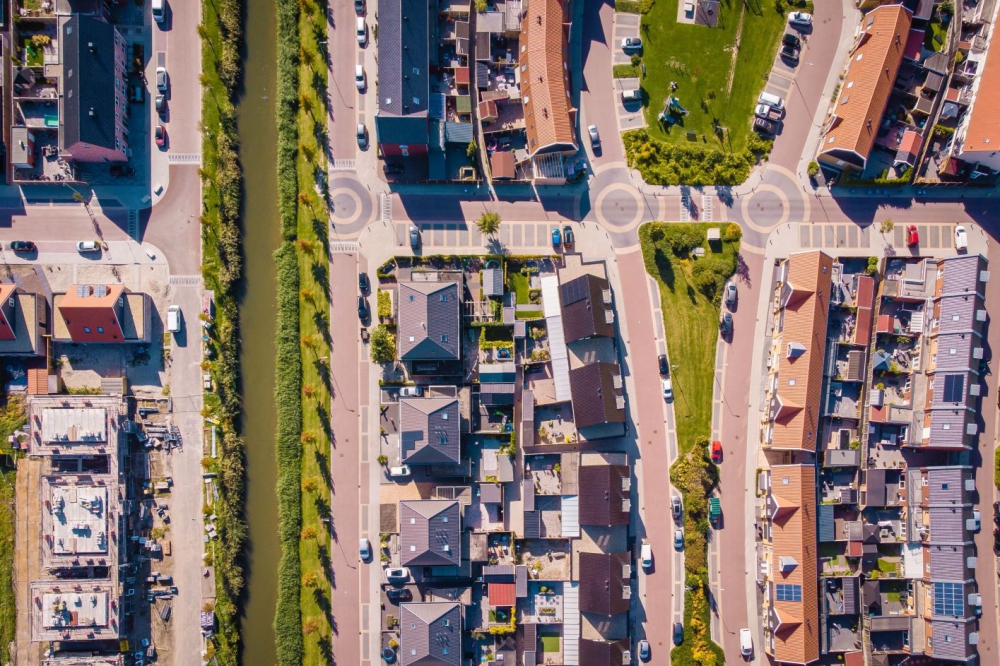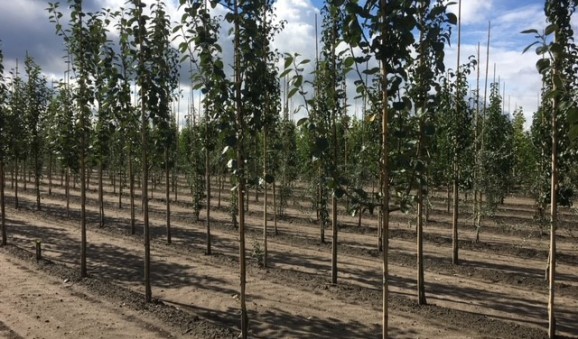ARE TREES TRULY INDISPENSABLE?

Trees are indispensable. We hear it regularly. And while it will undoubtedly be challenging to find someone who doesn’t love trees, it’s certainly interesting to take a closer look at what trees really yield, beyond providing a pleasant view. In this Nursery Gazette, we explore the (in)dispensability of trees, not limiting ourselves to sentiment but also delving into hard numbers.
What do trees do?
Let’s start with the actual function of trees; what do they do? The primary function of trees is oxygen production. They absorb water, sunlight, and CO 2 (carbon dioxide) and convert these into oxygenand nutritious sugars. This process enables humans and animals to breathe comfortably. Moreover, the CO 2 stored in the cells of the tree doesn’t end up in the atmosphere. In this way, an average tree removes about 10-40 kg of CO 2 from the air. Considering that an average Dutch household emits around 19,000 kg of CO 2 per year, it’s clear that trees have a significant task at hand! Trees also capture harmful and dirty particulate matter released into the air by agriculture and industry. This creates a difference in climate and temperature, such as in a forest or a city. In a paved environment, a much higher temperature is observed during warm weather, as the stone and concrete retain heat. Taking a walk in the forest, it’s pleasantly cool due to the shade of the trees and because trees use sunlight to evaporate water. The cooled leaf surface also cools the passing air.
The impact of trees on biodiversity and the environment
Trees also contribute to richer biodiversity. They provide shelter and refuge for animals and insects. Additionally, trees are a crucial food source for animals, thanks to their nuts and seeds. Trees improve soil life, from which they benefit themselves. Through photosynthesis, sugars are released into the roots, attracting fungi and bacteria. The tiny creatures attracted to this process, and the falling leaves, contribute to the formation of compost, which is essential for healthy trees.
With the rise in temperature, water evaporation also increases, which leads to soil drying out. Planting more trees in the right places creates cooling and keeps the soil fertile. Trees can also play a role in noise reduction. Planting a row of trees is an excellent and aesthetically pleasing way to dampen sound. Trees increase the value of real estate Research has shown that the presence of greenery has a positive effect on real estate value. A house with a green garden can be sold for 4 to 15% more than a similar house with a paved garden. Research has also demonstrated that the presence of greenery has a positive impact on (mental) health. Researchers from the RIVM, the Dutch National Institute for Public Health and the Environment, have created a model outlining the four ways in which greenery influences physical and mental health. The primary influences are positive: green can reduce the health damage caused by air pollution, heat, and noise. Greenery reduces stress, improves concentration, and encourages physical activity and social interaction. However, the RIVM notes that people may also experience issues with animals and plants, such as rats, mosquitoes, giant hogweed, or nettles.
Improved health for all ages
Greenery contributes to better mental health. A green environment encourages people to move andrelax, influencing both young and old. This contributes to the reduction of overweight, type 2 diabetes, cardiovascular diseases. The researchers at the RIVM also see a favourable relation between greenery and age, the birth weight of babies, and the functioning of the immune system. Greenery seems to contribute to improved sleep. Contact with greenery improves concentration, memory, and learning performance, an effect particularly observed in children. All these factors advocate for planting more trees. And, of course, it is always important to plant the right tree in the right place.
How significant are the benefits of trees?
We’ve listed some crucial benefits of trees. But as a government or even as a garden owner, you’d want to know how significant these tree benefits really are. What does a tree truly yield? To make this clear, the BomenMonitor (Tree Monitor) has now been included in the Pientere Tuinen app (Smart Gardens). With the BomenMonitor, which maps all municipal and private trees, you can see all the trees in the Netherlands, and their yield for society, in relation to health, well-being, climate, and biodiversity. The Pientere Tuinen project aims to collectively work towards planting 10% more trees in the Netherlands. Garden owners naturally play a crucial role in this. The project connects various elements needed to realise those additional 10% of green gardens. “With Pientere Tuinen, participants have a sensor in their garden that measures temperature and soil moisture. These data are made visible in the garden owner’s personal dashboard. One of the goals is to gain more insight into heat stress, dehydration, and waterlogging. To improve the interpretation of the data, it’s very useful to know if there are trees in the vicinity of the sensor. With the BomenMonitor, we get actual insight into that,” explains Arjen Hof, co-initiator of the project.
Making the benefits of a tree visible
“The BomenMonitor has mapped out all hundreds of millions of trees in the Netherlands, in public and private spaces, based on aerial photos, laser scan data, and satellite images,” says Joost Verhagen, director/senior advisor Trees, Nature, and Ecology at Cobra Green Insight. “Especially for the Pientere Tuinen project, we, together with WeCity, ensure that the benefits of a tree are made visible to the garden owner. These benefits depend on factors such as tree species, size, and location. This varies for each tree. This data is not yet known for every tree. Enlisting the help of garden owners to enrich the BomenMonitor with this data is a fantastic addition.” The use of the BomenMonitor allows design choices, project advice, and agreements on trees to be substantiated quickly and clearly with facts. The photos and graphical representations of tree sizes also make the BomenMonitor suitable for educational purposes, for example, to inform the city council or residents about choices made or available choices. Through the use of the BomenMonitor, design choices, project advice, and agreements regarding trees are substantiated in a thorough and clear manner with facts. The photos and graphic representations of tree sizes also make BomenMonitor highly suitable for educational purposes, for example, to inform the municipal board or residents about made or available choices.
Personal dashboard
Through this collaboration, the measurement results of Pientere Tuinen are also improved. “Garden owners can supplement missing data from a tree through their personal dashboard,” explains Verhagen. “And they can, for example, add a new tree that is not yet included in the BomenMonitor. This gives us an even more complete picture of the Dutch tree inventory. And that is important to determine how climate- and future-proof our tree inventory is.” Arjen Hof adds: “This way, we are able to better interpret our measurement data, provide our garden owners with better information and tips to make their gardens greener, and provide insight into the effect of a tree on their living environment. This is a great addition to achieving our goal of realizing 10% more green gardens in the Netherlands.”
Some facts...
In the Netherlands, we can find 1.04 million individual gardens, both for houses and for offices and factories. In total, this covers 2685 square kilometres of gardens. On average, the gardens are 38.6% green, so 61.4% is paved. There is still a lot of work to be done! And of course, municipalities play a part in this too. In addition to those 2685 square kilometres of gardens, there is also 9364 square kilometres of public space. So, there is a lot to be done there. While we currently only have 12.8 square kilometres in the Netherlands with temperatures being so high that we have to consider them as a desert, in 2090 (so in about 60 years), this will be an immense area of 6317.4 squarekilometres. That is an area the size of the municipality of Kaag en Braassem, which we won’t be ableto plant in if we do not intervene NOW.
